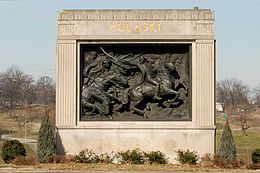Patterson Park
The park consists of open fields of grass, large trees, paved walkways, historic battle sites, a lake, playgrounds, athletic fields, a swimming pool, an ice skating rink and other signature attractions and buildings.
Its notable attractions include the boat lake (where fishing is permitted), the marble fountain, the Pulaski Monument, and the Patterson Park Observatory.
[5][6] The Patterson Park Observatory was built in 1891 as an observation tower for viewing the city and is still open to visitors.
Thus, before dawn on September 14, 1814, British commander Colonel Arthur Brooke decided the land campaign was a lost cause, and ordered the retreat back to the ships, and the United States was thus victorious in the Battle of Baltimore.
Several public accommodations at the park such as the swimming pools, picnic pavilions, and playgrounds were managed as "separate but equal" until they were desegregated in 1956.
[22] On October 10, 1962, President John F. Kennedy visited Baltimore and landed in his helicopter at the park and took an open top car to the 5th Regiment Armory.
[27] It was designed as a people's lookout tower with an Asian motif, inspired by Latrobe's fascination with the East.


